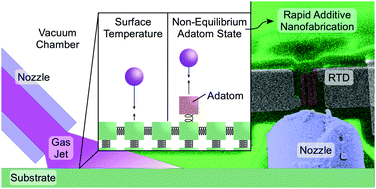Researchers at the Georgia Institute of Technology have developed a faster method of nano 3D printing with focused electron beams. A minute high-energy supersonic jet of gas is invented to accelerate the deposition of precursor materials. This technique has led to the discovery of a thermodynamic phenomenon and also new applications for 3D nanofabrication.
Focused Electron Beam Induced Deposition
Focused Electron Beam Induced Deposition (FEBID) is a direct-writing method of 3D nanofabrication. A beam of high energy electrons and a jet of thermally excited precursor gases focus on the same spot on a substrate. Deposition of precursor molecules occurs when the electron beam strikes the substrate. Complex nano 3D structures can be made in this way with precise control. Other than high deposition accuracy, FEBID also enjoys great freedom in deposit shape and composition.

Nanoscale 3D structures enables new approaches for health monitoring, computer processing and energy research. Other than FEBID, there are other 3D nanofabrication methods with functional applications. Penn State produced LEDs by two-photon polymerization and Singapore University of Technology and Design developed an anti-counterfeiting device by multiphoton lithography.
Accelerate nano 3D printing with supersonic jet
The major limitation to FEBID is its long production time which limits high volume production of nano-devices. Aiming to overcome this barrier, researchers searched for a method that increases the deposition speed without increasing the substrate temperature.
To energize precursor molecules, the team has invented a micro-capillary injector of a few micrometers in diameter. Entering the deposition vacuum chamber, the injector introduces tiny jets of gaseous molecules which accelerates to supersonic speeds. The precursor molecules adsorbed to the substrate are excited by the energy from the supersonic jet. In this activated state, chemical bonds between electrons from the beam break much more easily. As a result, the nano 3D printing process is sped up.
“All of this amplification, both the molecule transport and the rate of reaction, are exponential,” explained Andrei Fedorov, a professor in the George W. Woodruff School of Mechanical Engineering at the Georgia Institute of Technology.

Rapid 3D nanofabrication in non-equilibrium adatom state
After mastering the technique, the researchers wanted to understand the underlying physical phenomenon. Developing a theory about this 3D nanofabrication technique will help expanding it to other fields such as directed self-assembly, epitaxial growth and other areas.
Adatom (short for adsorbed atoms) temperature cannot be directly measured without disturbing its thermodynamic state. Therefore, the team developed a nano-scale thermometric model to predict both the adatom effective temperature and the surface temperature in response to supersonic microjet gas impingement.

A new state of radical thermal non-equilibrium in surface adsorbed molecules was discovered by this model. This unique thermal state allows rapid surface diffusion of energized adatoms, hence increased growth rates without changing the substrate surface temperature. The ability to control the adatom effective temperature allows control of the surface diffusion rate. This enables a whole host of nanoscale additive manufacturing processes that depend on surface diffusion of precursor molecules.
Applications of 3D nanofabrication with supersonic jets
Researchers believe their theory can lead to new applications for additive nanomanufacturing and new nanoscale materials. “If you can adapt additive direct-write techniques, this could bring a lot of unique capabilities for magnetic memory, superconducting materials, quantum devices, 3D electronic circuitry, and many more things,” Fedorov said. “These structures are currently very hard to make using conventional methods.”

In future work, the researchers plan to use hybrid jets that contain both high-energy inert gas and precursor gases. Other than dramatic acceleration of 3D nanofabrication, hybrid jets can also precisely control the material composition during 3D printing. This enables formation of nanostructures with phase and topology beyond the reach of existing nanomanufacturing techniques.
“Non-equilibrium adatom thermal state enables rapid additive nanomanufacturing.”is published online in Physical Chemistry Chemical Physics journal. It is co-authored by Matthew R. Henry, Songkil Kim and Andrei G. Fedorov.
For more of the latest 3D printing research sign up to the 3D Printing Industry newsletter, follow us on Twitter, and like us on Facebook.
On the lookout for new talent or seeking a career change? Search and post 3D Printing Jobs for opportunities and new talent across engineering, marketing, sales and more.
Featured image shows an SEM image of the position of a nanoscale thermometer as the deposition substrate moves relative to the micro-size nozzle capillary for gas jet injection for mapping local temperature. Image via Georgia Institute of Technology.


